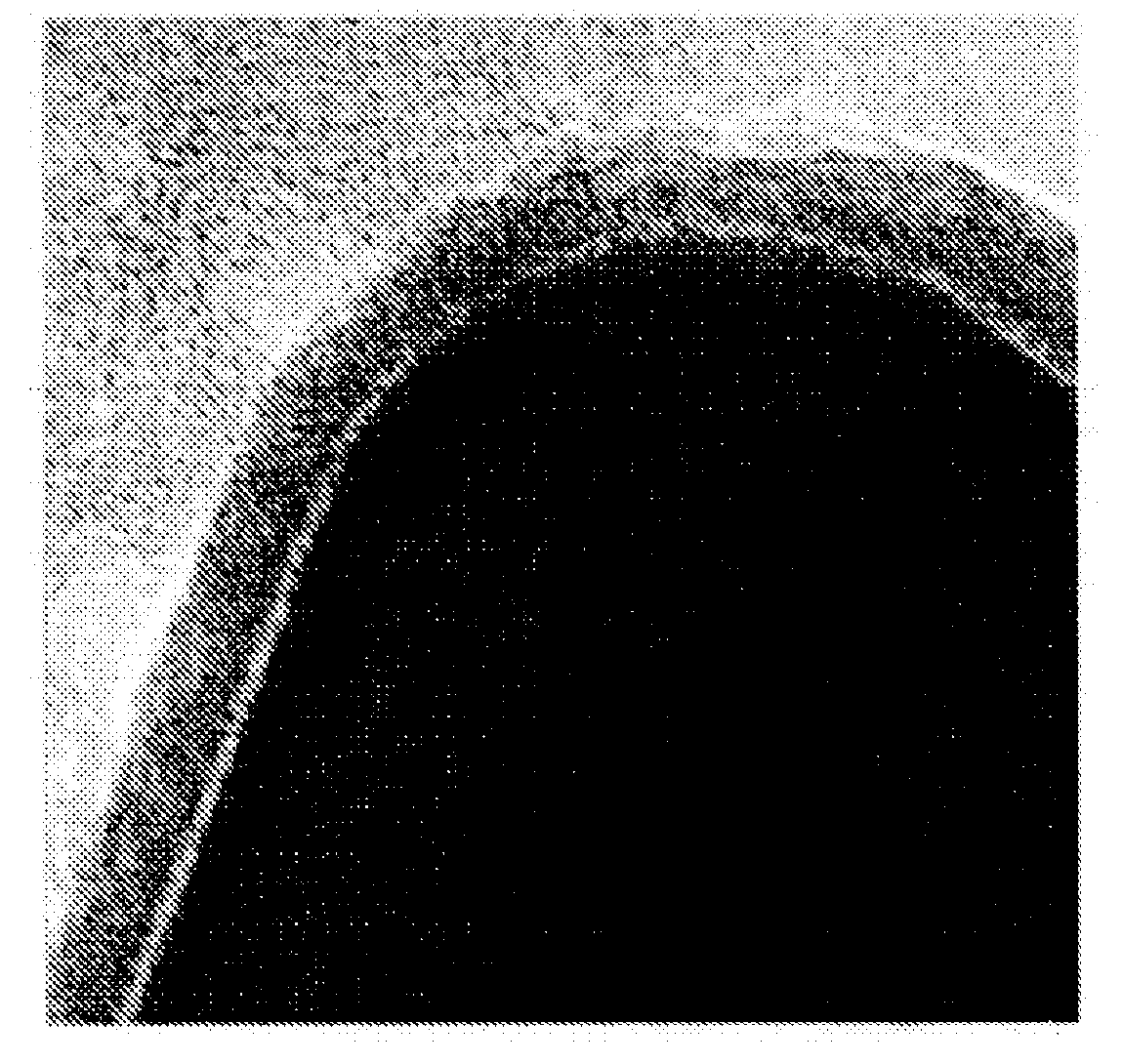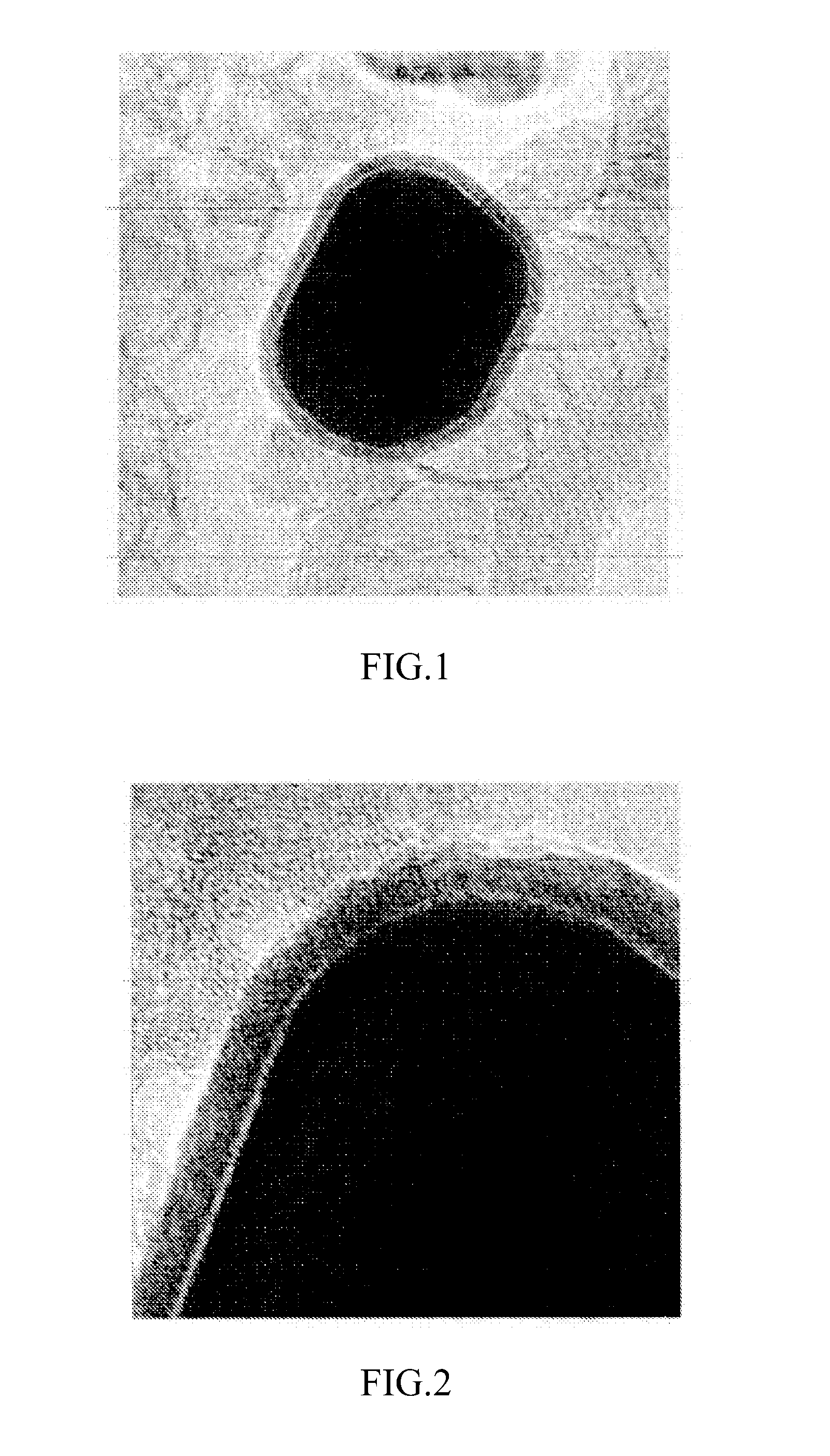Composite positive electrode material with core-shell structure for lithium ion batteries and preparing method thereof
a lithium ion battery and positive electrode technology, applied in the direction of iron compounds, cell components, electrochemical generators, etc., can solve the problems of single positive electrode material not meeting the requirements of different electricity appliances, poor cycle performance, and own defects, so as to improve the specific capacity and specific energy, improve the conductivity and circulation stability, and improve the effect of positive active material ra
- Summary
- Abstract
- Description
- Claims
- Application Information
AI Technical Summary
Benefits of technology
Problems solved by technology
Method used
Image
Examples
first embodiment
The First Embodiment
[0024](a) Preparing a core active material which includes: dissolving 320 g glucose into 1000 g water; adding 69 g lithium nitrate (LiNO3, 1 mol) and 251 g manganese nitrate (Mn(NO3)2.4H2O, 1 mol) into the solution; putting the solution in nitrogen and heating the solution at a temperature of 100° C. for 2 hours to get gels; sintering the gels in hydrogen atmosphere and at a temperature of 500° C., and keeping the sintering temperature constant for 16 hours to get a core active material lithium manganate LiMnO2.
[0025](b) Preparing a composite positive material with a core-shell structure for a lithium-ion battery which includes: dissolving 586 g glucose into 1000 g water; adding 10.35 g lithium nitrate (LiNO3, 0.15 mol), 80.8 g ferric nitrate (Fe(NO3)3.9H2O, 0.2 mol), 23 g ammonium dihydrogen phosphate (NH4H2PO4, 0.2 mol) and 3.1 g boric acid (H3BO3, 0.05 mol) into the solution; mixing 3 g carbon nanotube and 3 g polyving akohol and then ultrasonic dispersing int...
second embodiment
The Second Embodiment
[0027](a) Preparing a core active material which includes: dissolving 1055 g sucrose into 1000 g water; adding 37 g lithium carbonate (Li2CO3, 0.5 mol) and 490.2 g manganese acetate (Mn(CH3COO)2.4H2O, 2 mol) into the solution; heating the solution in nitrogen and at a temperature of 150° C. for one and a half hours to get gels; sintering the gels in nitrogen atmosphere at a temperature of 700° C., and keeping the sintering temperature constant for 10 hours to get a core active material lithium manganate LiMn2O4.
[0028](b) Preparing a composite positive material with a core-shell structure for a lithium-ion battery which includes: dissolving 388 g sucrose into 1000 g water; adding 3.7 g lithium carbonate (Li2CO3, 0.05 mol) and 14.4 g ferrous oxalate (FeC2O4.2H2O, 0.08 mol), 7.5 g aluminium nitrate (Al(NO3)3.9H2O, 0.02 mol), 13.2 g diammonium hydrogen phosphate ((NH4)2 HPO4, 0.1 mol) into the solution; mixing 1.5 g superfine conductive carbon black and 15 g polyeth...
third embodiment
The Third Embodiment
[0030](a) Preparing a core active material which includes: dissolving 1314 g edetic acid into 1000 g water; adding 459 g lithium oxalate (Li2C2O4, 4.5 mol) and 1159 g ferrous carbonate (FeCO3, 10 mol), 30.8 g cadmium nitrate (Cd(NO3)2.4H2O, 1 mol) and 980 g phosphoric acid (H3PO4, 10 mol) into the solution; putting the solution in nitrogen and heating the solution at a temperature of 200° C. for one hour to get gels; sintering the gels in nitrogen atmosphere at a temperature of 900° C., and keeping the sintering temperature constant for 3 hours to get a core active material Li0.9Cd0.1FePO4.
[0031](b) Preparing a composite positive material with a core-shell structure for a lithium-ion battery which includes: dissolving 244 g edetic acid into 1000 g water; adding 4.8 g lithium hydroxide (LiOH, 0.2 mol), 19.2 g iron hydroxide (Fe(OH)3, 0.18 mol), 5.1 g magnesium nitrate (Mg(NO3)2.6H2O, 0.02 mol) and 19.6 g phosphoric acid (H3PO4, 0.2 mol) into the solution; mixing 1...
PUM
| Property | Measurement | Unit |
|---|---|---|
| temperature | aaaaa | aaaaa |
| temperature | aaaaa | aaaaa |
| temperature | aaaaa | aaaaa |
Abstract
Description
Claims
Application Information
 Login to View More
Login to View More - R&D
- Intellectual Property
- Life Sciences
- Materials
- Tech Scout
- Unparalleled Data Quality
- Higher Quality Content
- 60% Fewer Hallucinations
Browse by: Latest US Patents, China's latest patents, Technical Efficacy Thesaurus, Application Domain, Technology Topic, Popular Technical Reports.
© 2025 PatSnap. All rights reserved.Legal|Privacy policy|Modern Slavery Act Transparency Statement|Sitemap|About US| Contact US: help@patsnap.com


